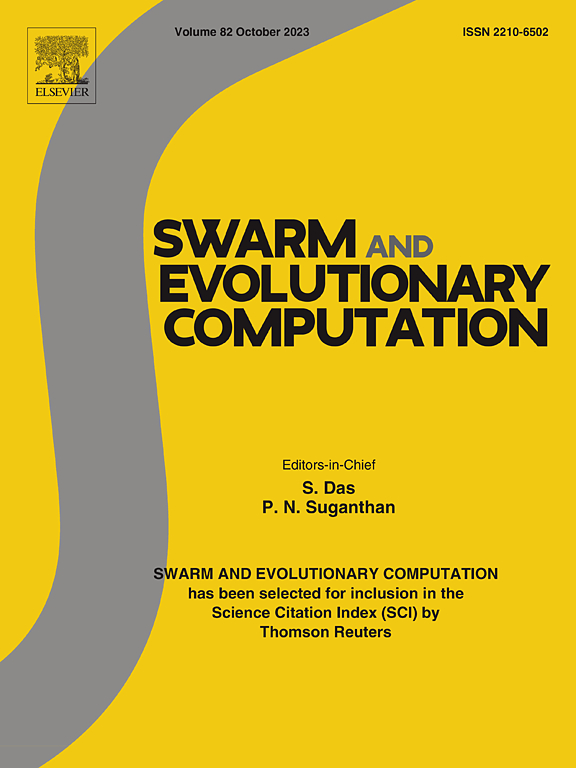A dynamic multi-objective optimization evolutionary algorithm based on classification of decision variables and inter-layer collaborative prediction
IF 8.2
1区 计算机科学
Q1 COMPUTER SCIENCE, ARTIFICIAL INTELLIGENCE
引用次数: 0
Abstract
The Dynamic Multi-objective Optimization Evolutionary Algorithm (DMOEA) demonstrates outstanding performance in addressing complex Dynamic Multi-objective Optimization Problems (DMOPs). However, existing DMOEAs lack a mechanism for classifying decision variables, which makes it challenging for the population generated by the response mechanism to achieve a balance between convergence and diversity, thereby compromising the algorithm’s overall optimization performance. For this reason, this work presents a DMOEA based on decision variable classification and inter-layer collaborative prediction. First, the algorithm classifies decision variables into two types (elite decision variables and routine decision variables) by detecting their characteristics and designs corresponding response mechanisms for different variables. Second, an inter-layer collaborative prediction strategy based on the Gate Recurrent Unit (GRU) model is proposed to handle routine decision variables, while elite decision variables are optimized using a Latin Hypercube Sampling (LHS) strategy. Subsequently, the two types of optimized variables are combined to form the final predicted population. Finally, a population re-optimization strategy (including dominant solution filtering and adaptive mutation) is proposed to finely optimize the predicted population, thereby further improving prediction accuracy. Through experiments on 24 test functions with seven high-performance DMOEAs, it is demonstrated that the algorithm has significant advantages in both convergence and diversity.
基于决策变量分类和层间协同预测的动态多目标优化进化算法
动态多目标优化进化算法(DMOEA)在解决复杂的动态多目标优化问题(dmoops)方面表现出优异的性能。然而,现有的dmoea缺乏对决策变量进行分类的机制,这使得响应机制生成的种群难以在收敛性和多样性之间取得平衡,从而影响了算法的整体优化性能。为此,本文提出了一种基于决策变量分类和层间协同预测的DMOEA。首先,该算法通过检测决策变量的特征,将其分为精英决策变量和常规决策变量两类,并针对不同的变量设计相应的响应机制。其次,提出了一种基于门循环单元(GRU)模型的层间协同预测策略来处理常规决策变量,同时采用拉丁超立方采样(LHS)策略对精英决策变量进行优化。随后,将两类优化变量组合,形成最终的预测总体。最后,提出了一种种群再优化策略(包括优势解滤波和自适应突变),对预测种群进行精细优化,从而进一步提高预测精度。通过7个高性能dmoea对24个测试函数的实验,证明了该算法在收敛性和多样性方面都具有显著的优势。
本文章由计算机程序翻译,如有差异,请以英文原文为准。
求助全文
约1分钟内获得全文
求助全文
来源期刊

Swarm and Evolutionary Computation
COMPUTER SCIENCE, ARTIFICIAL INTELLIGENCEC-COMPUTER SCIENCE, THEORY & METHODS
CiteScore
16.00
自引率
12.00%
发文量
169
期刊介绍:
Swarm and Evolutionary Computation is a pioneering peer-reviewed journal focused on the latest research and advancements in nature-inspired intelligent computation using swarm and evolutionary algorithms. It covers theoretical, experimental, and practical aspects of these paradigms and their hybrids, promoting interdisciplinary research. The journal prioritizes the publication of high-quality, original articles that push the boundaries of evolutionary computation and swarm intelligence. Additionally, it welcomes survey papers on current topics and novel applications. Topics of interest include but are not limited to: Genetic Algorithms, and Genetic Programming, Evolution Strategies, and Evolutionary Programming, Differential Evolution, Artificial Immune Systems, Particle Swarms, Ant Colony, Bacterial Foraging, Artificial Bees, Fireflies Algorithm, Harmony Search, Artificial Life, Digital Organisms, Estimation of Distribution Algorithms, Stochastic Diffusion Search, Quantum Computing, Nano Computing, Membrane Computing, Human-centric Computing, Hybridization of Algorithms, Memetic Computing, Autonomic Computing, Self-organizing systems, Combinatorial, Discrete, Binary, Constrained, Multi-objective, Multi-modal, Dynamic, and Large-scale Optimization.
 求助内容:
求助内容: 应助结果提醒方式:
应助结果提醒方式:


